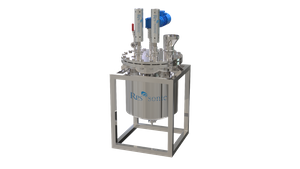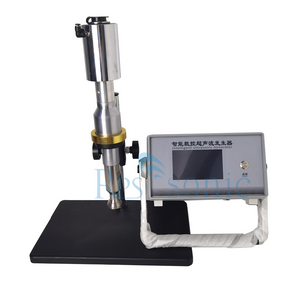Background technology
Seaweed polysaccharides are a type of multi-component mixture. The composition and activity of polysaccharides obtained from different seaweeds by different extraction methods vary greatly. Seaweed polysaccharides are polar macromolecular compounds that contain a large number of hydroxyl groups and are easily soluble in water. At present, the extraction of seaweed crude polysaccharides at home and abroad mainly adopts the method of dilute alkali, dilute acid and hot water extraction. Its advantages are simple process, convenient operation and low cost, but it also has disadvantages such as low extraction rate, large activity loss and difficulty in filtration and purification, which greatly limits the large-scale industrial production of seaweed polysaccharides.
The traditional methods for extracting seaweed polysaccharides are mainly acid extraction, alkali extraction, enzyme extraction, etc. Acid extraction is used to extract polysaccharides soluble in dilute acid aqueous solution, and a lower pH value can avoid the dissolution of alginate; alkali extraction is often used to extract alkali-soluble polysaccharides and sodium alginate; enzyme extraction conditions are mild and can effectively maintain the naturalness of seaweed polysaccharides. However, all of the above extraction methods have certain defects: acid extraction method easily causes polysaccharide hydrolysis, alkaline extraction method easily causes polysaccharide biological activity to decrease, enzyme extraction method is time-consuming, industrial production requires a large amount of enzyme, and the cost is high.
Chinese patent CN102850410A discloses a method for extracting seaweed polysaccharides from waste beer yeast, which belongs to the category of biotechnology. This method uses waste beer yeast as raw material to prepare seaweed polysaccharides. The main process is to pre-treat the waste beer yeast to remove impurities and then dry and inactivate the enzyme, and then use Soxhlet extraction to obtain seaweed polysaccharide extract, and further decolorize with activated carbon, precipitate and deproteinize with alkali metal salts, remove impurities with ion exchange, concentrate, and crystallize and dry to obtain seaweed polysaccharides. The purity reaches more than 98.5%, which can be used in the fields of medicine, cosmetics and food. The present invention has the characteristics of high raw material utilization, low cost, simple process, easy method, safe operation and high product purity, and is easy to industrialize. However, the time required for the entire process is still relatively long, and there are defects such as time-consuming and labor-consuming.
Invention content
In order to overcome the shortcomings of the prior art, the present invention provides a device and method for ultrasonic-assisted extraction of seaweed polysaccharides.
A device for ultrasonic-assisted extraction of seaweed polysaccharides, the device comprising an extraction reactor, an ultrasonic generator and a temperature control device, the extraction reactor is provided with an extraction tube for placing the extract, the tube wall of the extraction tube is provided with a plurality of through holes, the number of the ultrasonic generator is more than one, each ultrasonic generator is connected to the inner cavity of the extraction reactor through a corresponding ultrasonic probe, the ultrasonic probe is evenly arranged in the extraction reactor and outside the extraction tube; the temperature control device comprises a temperature controller, a temperature sensing probe and a heating tube, the temperature sensing probe and the heating tube are respectively connected to the temperature controller, the temperature sensing probe and the heating tube are arranged in the extraction tube; the bottom of the inner cavity of the extraction reactor is connected to a pump.
The design of the through hole of the present invention enables the extracting liquid to not only infiltrate the extracting liquid to achieve effective extraction, but also prevent the debris of the extracting liquid from being mixed in the extracting liquid, which is convenient for the next step of processing. In addition, it helps the liquid in the extraction tube and the liquid in the extraction reactor to realize the circulation alternation. When the concentration of the liquid in the extraction tube is high, it starts to flow into the extraction reactor outside the extraction tube. At the same time, the liquid in the extraction reactor outside the extraction tube enters the extraction tube, avoiding the influence of high viscosity on the extraction efficiency. After the extraction is completed, the extract can be pumped out by a pump connected to the bottom of the inner cavity of the extraction reactor, which is more conducive to automation.
In the present invention, more than one ultrasonic probe is evenly arranged in the extraction reactor, so that the ultrasonic action is uniform and the extraction effect is better. The temperature sensing probe and the heating tube are arranged in the extraction tube, which can more effectively control the temperature.
Preferably, the device also includes a stirring device, the stirring device includes a stirrer and a stirring paddle, the stirring paddle is connected to the stirrer, and the stirring paddle extends from the top of the extraction reactor and is located in the extraction tube. Further improve the extraction efficiency.
Preferably, the upper end and the lower end of the extraction tube are respectively separated from the upper end and the lower end of the extraction reactor. So that the ultrasonic energy of the extract to be treated can be carried out evenly and smoothly, and the extraction efficiency is improved.
Preferably, the extraction tube is concentrically located in the extraction reactor.
A method for ultrasonic-assisted extraction of seaweed polysaccharides comprises the following steps:
(1) crushing kelp, hijiki or wakame, passing through a 60-mesh sieve, and placing the kelp in a filter paper bag or gauze to obtain an extract;
(2) placing the extract in an extraction tube, adding a certain volume of water to an extraction reactor, and extracting by ultrasonic crushing for a period of time to obtain an extract; wherein the various conditions in the extraction reactor are respectively controlled as follows: a material-liquid mass ratio of 1:32-46, an ultrasonic frequency of 20-100 kHz, an ultrasonic power of 120-200 W, an extraction temperature of 25-55°C, and an extraction time of 22-28 min;
(3) the extract is further centrifuged, concentrated, ethanol precipitated, and filtered to obtain crude seaweed polysaccharides;
(4) purifying the crude seaweed polysaccharides by DEAE cellulose column chromatography, and finally spray drying or freeze drying to obtain pure seaweed polysaccharides.
Preferably, in step (2), the material-liquid mass ratio is 1:35-38, the ultrasonic frequency is 35-60kHz, the ultrasonic power is 145-167W, the extraction temperature is 30-40°C, and the extraction time is 23-26min.
Preferably, in step (3), the extract after centrifugation is concentrated to 1/5-1/7 of the original volume, and the volume ratio of the concentrate to ethanol is 1:3.2-3.7.
Preferably, in step (4), the eluent is a pH 7.2, 0.01mol/L NaH2PO4-NaHPO4 buffer.
Step (2) of the present invention can be repeatedly extracted more than 2 times according to actual conditions. When DEAE cellulose column chromatography is used for purification in step (4), the elution rate can be adjusted according to actual conditions.
The present invention is suitable for industrial production, and its scaled-up production can still maintain a good extraction effect, which not only reduces the extraction temperature and improves the extraction rate, but also greatly shortens the extraction time.
Ultrasonic assisted extraction uses the cavitation, mechanical and thermal effects generated by high-frequency oscillation of ultrasound to form a local high temperature and high pressure environment inside the object, causing deformation and rupture of plant and animal cell tissues, and promoting the dissolution of effective ingredients in the cells. It has the advantages of less loss of active ingredients and high extraction efficiency.
When an object is acted on by ultrasound with the same energy but different frequencies, the results may be different. Of course, the results of ultrasound with the same frequency but different powers, that is, different energies, are also different.
The seaweed polysaccharides extracted by the present invention can be developed into beverages, oral liquids, capsules and other products.
The method of the present invention is simple and easy to operate. The seaweed polysaccharides extracted by the method of the present invention are short in time and high in purity, which can reach more than 98%; it can not only save costs, reduce energy consumption, and facilitate automation, but also improve extraction efficiency.
 English
English












